
According to a handy fact sheet from Washington State University, Coffee grounds will buzz your garden. Coffee grounds build humus, boost nitrogen, phosphorus and zinc, bind pesticides and toxins, prevent bacterial and fungal infections and feed earthworms. Authored by Dr. Linda Chalker-Scott, Extension Urban Horticulturist and Associate Professor, this peer-reviewed pamphlet also provides a set of suggestions for using coffee grounds in the garden:
- Coffee grounds should be composted before used as a soil amendment but can be used fresh as a mulch.
- Fresh grounds are phytotoxic, so keep them away from direct contact with roots.
- Coffee grounds will not necessarily make your soil more acidic.
- Don’t use coffee grounds where you are starting seeds.
- Despite rumors, coffee grounds do not repel pests.
- Let coffee grounds cool before adding to compost bin so you don’t kill beneficial microbes. And don’t let coffee grounds amount to more than 20% of your compost pile.
- Don’t add coffee grounds to vermicomposting bins.
If you’re using coffee grounds as a mulch Chalker-Scott has two suggestions:
- Apply a thin layer (no more than half an inch) of coffee grounds. Cover with a thicker layer (four inches) of coarse organic mulch like wood chips (Chalker-Scott 2015). This will protect the coffee grounds from compaction.
- Don’t apply thick layers of coffee grounds as a standalone mulch. Because they are finely textured and easily compacted, coffee grounds can interfere with moisture and air movement in soils.

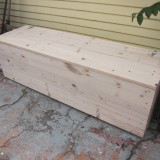
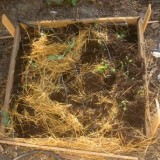

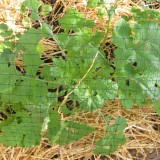
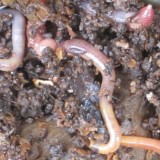
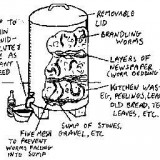
Living in the Seattle area, it is easy to find large amounts of coffee grounds. I pick up bags and bags of them from Starbucks and spread them all over the yard. I have no idea if it is helping, but it certainly isn’t hurting anything and it is free.
Wait, I thought coffee grounds were good for my worm bin! I don’t see anything pro- or anti- coffee grounds in vermiculture in the PDF. Did I miss it?
I threw a whole bag of coffee grounds on top of a half finished worm bin, kind of forgot about it for a month or so, and when I went to fetch the plastic bag out of the bin, lo and behold, it was extremely saturated with lots of worms (high on caffeine too!)
So what’s with the caution?
There are not any reasons to add them to worm bins. I have seen worm bins do well on only coffee and no other additions.
I do not agree with the recommendation of not adding used coffee grounds to vermicompost bins.
From the factsheet:
“Avoid adding coffee grounds to vermicomposting bins; they can injure or kill earthworms in these confined areas (Liu and Price 2011)”
From the paper(Evaluation of three composting systems for the management of spent coffee grounds, K. Liu, G.W. Price):
“Plastic containers measuring 37.4 cm x 24.1 cm x 14 cm and able to hold approximately 2 L of material were used as vermicompost bins. Twenty worms weighing approximately 0.3 g were placed in the vermicompost bins containing 2 kg of treatment materials. Replicates of the four treatments were randomly assigned to a location within a block set up on the 2.5 m x 1 m table. Analysis for moisture content of the vermicomposts occurred during each sampling period and water added to maintain the compost at 60% (USCC, 2002). One sample from each replicate was collected every 14 days over the 72 days of the vermicomposting study.”
They used four treatments of bedding in the vermicompost bins. The control was only the spent coffee grounds as they had received them and without filters. The other treatments were as follows:
-spent coffee and cardboard at a ratio of 8:2,
-spent coffee and filters as they were received, and
-spent coffee and filters as they were received with added shredded cardboard (10:1 coffee and filters:shredded cardboard).
The containers with coffee alone had a 84% mortality rate, and coffee with filters, 76% mortality. In the treatments that received coffee with filters and shredded cardboard, and coffee with cardboard, mortality rates were 19% and 38% respectively. I think the high mortality observed in the small 2L bins with such large proportions of coffee is to be expected. So, leaping into “don’t use coffee in worm bins” doesn’t make sense to me.
From the results and discussion section:
“The results also suggest that the cardboard percentage should be higher than 40% to reduce earthworm mortality, but future study is needed to determine the optimal ratio of SC to cardboard to maximize the earthworm
survival and vermicompost quality. For example, additions of cardboard, in proportions greater than 40%, significantly reduced earthworm mortality from 98% in the SC treatment to 13% in the SCFC treatment. In addition, the raw SC may need to be pre-composted for about 3 weeks prior to earthworm addition to reduce exposure to volatile toxic substances and high temperatures (Adi and Noor, 2009), which might occur with larger quantities of feedstock as observed in our aerated static pile treatments.”
In the conclusion of this study, the authors say,
“Results of this study indicate that [spent coffee] can be successfully composted using in-vessel, static aerated pile or vermicomposting systems. … Earthworm survival in SC alone was low and suggests a requirement to mix with other feedstocks for successful vermicomposting.”
This makes sense to me. Don’t worry about adding small amounts of used coffee grounds to worm bins. If you are adding large proportions of coffee grounds, pre-compost the grounds for 3 weeks before adding them to your worm bins while maintaining a good balance between C:N.
Thanks PP–I was just sent that study in Facebook via the Garden Professor’s FB group. And, yes, it seems like you shouldn’t worry about the issue unless you were just adding a large amount of fresh coffee grounds.
I too have had a good experience with using coffee grounds in a compost bin.Lots of collected grounds just emptied straight in to a bin & left unattended. May be the very occasional addition of household vege scraps. A few months later the bin was loaded with more worms than I had ever seen in one spot & the grounds were nicely decomposed.
Pingback: Should I Put Coffee Grounds in a Worm Bin? | Root Simple
all compost will compost. I’ve never been a fan of the official version of the truth as dispersed by the knowledge -based University system. They look things up online. Any materials like hugelkultur wood debris will compost. I use coffee grounds all the time. Worms have no problem with anything we provide them. most of the “concerns” are caused by people looking stuff up online, and they “know” that woo woo, this is a problem, because it says so. scatter them in a thin layer? You can if you want.
Pingback: Three Alternative Ways to use Coffee Grounds this Summer! | muldoonscoffee